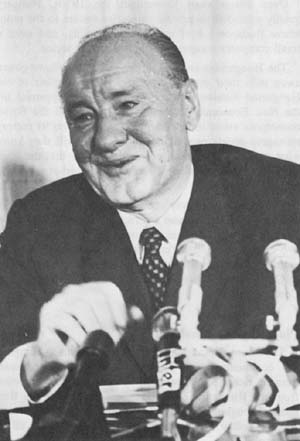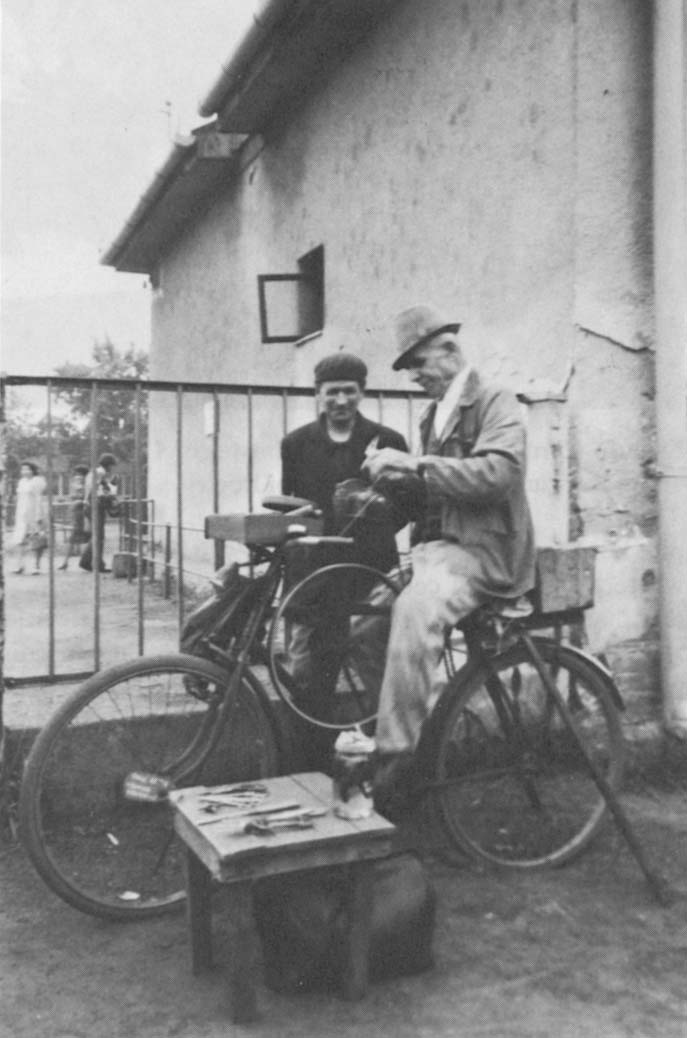BUDAPEST–Young people in their Hungarian-made Levi-Strauss jeans move around Budapest in large packs that congregate in restaurants and bars, drinking beer, eating wholesome snacks like steak tartare, and open to anyone who wants to lean elbows with them. Parties are organized on short notice to celebrate any handy event.
The hostess spends an afternoon making open-faced sandwiches out of salami and pickles, egg and paprika, or cream cheese and spices. Later, everyone will contribute for the wine, beer and food. The music will be on a tape or cassette taken from the radio or friends’ records. The room is dark. People sit around the periphery on beds, chairs, the floor. Brave ones will get up and dance. Those sitting have plenty to talk about, as Hungary undergoes an economic revolution that is reaching down to touch anyone who wants it to.
The economic revolution is anti-Communist in everything but name: it believes in private enterprise, contested elections and consumer democracy. It eschews central planning, fixed prices and a monopoly of power for the Communist Party. In joining the International Monetary Fund last year, Hungary has even joined the Western economic system, which originally stood for everything the Russians are supposedly against.
According to his rather envious brother-in-law, one Budapest architect will be a Hungarian millionaire in two years. Having worked in a state owned firm, the architect and 15 colleagues left their state jobs to start building apartment houses in Budapest.
They are taking advantage of legislation that went into effect last year allowing citizens to form private companies with as many as 30 employees. Five such firms can be combined into a single unit of as many as 150 employees and all private firms are eligible for venture-capital loans. Major enterprises are already autonomous, with prices and contracts between firms replacing the original socialist model of enterprises merely fulfilling ministry-directed production quotas. Profit-sharing was introduced as early as 1957, but its importance has increased to represent a major portion of managers’ compensation. Now Hungarians even have private corporations which are unique to socialism.
The architect is particularly well placed to take advantage of the new private-enterprise law because housing is in chronic short supply in all socialist countries. The governments pride themselves on cheap rent, and so do not raise enough money from one apartment block to build the next one. As a result, housing is always at a premium and the new law on private enterprise will give legal standing to the informal system that now prevails, where those who can afford it build buildings as cooperatives and take their share as an apartment. The formalized system will allow cash payments for putting up buildings and the chance to build a number of them at a time.
The Hungarian government is now contemplating issuing mortgage bonds to help further finance the private-sector housing market. For the first time since socialism was established in the country after World War II, people will be able to invest in outside banks and get a fair return on their money. Savings banks give two percent interest and many people, considering Hungary’s rocky history, prefer to keep their money in a mattress.
There is no doubt that the idea of commercial bonds goes against the whole thrust of Marxism and socialism. It is capitalism pure and simple. The Hungarians even discuss the possibility of people turning into “coupon cutters”, those “parasites on society” who make their money from the sweat of other people’s labor. It was quite an issue in the Hungarian press and finally had to be taken up by the Hungarian National Bank, the highest financial authority in the country. The bank, which like any other, wants money to remain productive and used for investment, backed the bonds with the dictate, “It is possible to float mortgage bonds in every social system that recognizes personal or private real estate and therefore also to grant mortgage loans. Therefore the mortgage bond and the loans serving as the basis for issuing such bonds are by no means capitalist concepts.”
Individuals like this architect are affected by decisions that are slowly unraveling Hungary’s prejudices to capitalism. The rhetoric and the labels are disappearing more slowly than the actual accommodation to capitalism.
Hungary joined the International Monetary Fund in May, 1982, an event that turned back the clock thirty-five years when Stalin told the Eastern Europeans to refuse Marshall Aid and International Monetary Fund membership.
Hungary trades as much with the West as it does with the Soviet Union and the Council for Mutual Economic Assistance, or Comecon, the Eastern European version of the Common Market.
Hungary has a joint venture Levi-Strauss factory producing a million pairs of jeans.
Hungary has an investment bank owned one-third by Hungary and two-thirds by Western and Japanese private banks.
There are more than 12,000 privately licensed companies in Hungary.
Hungary has a private computer manufacturer and its Rubic cube inventor is a millionaire thanks to his cube, its private cooperative manufacturer in Budapest and its licenses abroad.
“A young man in Hungary,” said the editor of a Budapest magazine, “wants his Coca-Cola, his disco and his Adidas. He doesn’t care about politics. He lives like a Westerner.”
The past ten years have seen Hungary perform an economic miracle that draws it much closer to the west and further from economic domination by the Soviet Union and Comecon. These changes, which the Soviet Union has tolerated in the context of détente, represent a formidable achievement not only for the Hungarians but also for Western Europe, especially West Germany, which is now Hungary’s second largest trading partner. Since Hungary is the envy of all the Comecon countries, it provides a model for the kind of economic development the Soviet Union will tolerate. Praise for Hungary’s agriculture, despite its heavy reliance on private enterprise, came from no less a source than the latest Soviet Communist Party Congress, which has resulted in an endless stream of Soviet agricultural experts coming to observe Hungarian farming cooperatives.
Janos Kadar, who was brought in by the Russians to rule Hungary after the abortive revolution in 1956, is the most successful Eastern European leader. Having started out betraying the Hungarian revolution, he has ended up the only electable official in the Communist bloc. He has succeeded by bringing his own revolution to Hungary without arousing the opposition of the Kremlin.

In joining the International Monetary Fund, the Hungarians could even go public with their quiet revolution. For years they begged visiting journalists not to contrast Hungary with the Soviet Union. It could only harm them and encourage the Russians to crack down.
Now the Hungarians are braver and not only joined the IMF, but also criticize Soviet trading policy as practiced in Comecon. The Hungarians making the criticisms are not, to be sure, political rabble rousers. They are economists, who enjoy the greatest prestige in Hungarian society. They get away with criticisms that the Soviet Union exploited Hungary and the other satellites, just as a Hungarian banker was the one to make the IMF application, which amounted to Hungary’s long-planned and cautiously executed declaration of independence from the Eastern trading bloc.
Soon after the Hungarian Revolution in 1956, Kadar convened a group of top Hungarian economists, including those who had served in the pre-war fascist regime of Admiral Horthy. The economists’ assignment, as described by one of them who is now a director of the National Bank of Hungary, was to satisfy Hungarian consumers. As in any Eastern European country, the first complaint was food, which is a universal problem because agricultural output is traditionally monopolized by the government through compulsory purchasing. Farmers are paid what the government decides they should get. In bad years when production is low and the prices do not increase, farmers actually lose money on their crops.
Hungarian farmers after 1956 were allowed to charge a free market price for their crops, and as a result, Hungary has an agricultural output that in crops per acre rivals America’s.
Over fifteen years throughout the 1970s, Hungary quietly extended its private-enterprise system to the point where Budapest’s best restaurants, housing, and even a small computer company are in the private sector.
The Hungarians are still surprised that they have gotten away with their maverick policies. One member of the Hungarian mission sent to Moscow to get approval for the New Economic Mechanism in 1968 said the Soviet economists asked in bewilderment, “But if you let factory managers decide production quotas, how will they know what to do?” Hungarian economists swear that the Russians let them experiment without realizing what was going on.
The Hungarians never intended to conduct their revolution alone. Kadar became a personal adviser to Alexander Dubcek in Czechoslovakia, hoping that reforms in the two countries could be coordinated. Kadar met secretly with Dubcek three times to warn him of Soviet opposition to Czech reforms that seemed to overwhelm the country’s Communist Party.

Placating the Russians
The fall of Dubcek did not stop the reforms in Hungary, but conducting them alone in Eastern Europe meant drawing closer to Western Europe and possible objection from the Russians. Kadar managed to placate the Russians throughout the 1970s, luckily aided by Nixon’s détente policy which loosened the isolation of all of Eastern Europe.
Kadar’s Hungary, however, was the only Eastern European country that knew what to do with the loans it got from the West. It invested that money in improving the country’s efficiency and cutting its energy consumption, while other countries, notably Poland, financed consumer consumption or industries incapable of producing export-quality goods.
Hungary has been allowed its present latitude in part because of its intransigent political stance behind the Soviet Union. But from the banks of the Danube in Budapest, Hungary looks like it is paying a very small price for the achievements it has been allowed to make with no external interference. Censorship is largely confined to not offending the Soviet Union.
Lech Walesa, the Solidarity union leader in Poland, was even on Hungarian television, an event unique in Eastern Europe outside of Poland. The Hungarians closely questioned Walesa in the summer of 1981 about the responsibility Solidarity took for the productivity of its workers. The Hungarians wanted to know about the economic side of the Polish trade union movement.
Though the two countries have a long history of close ties going back to Zsigmond Bathory who ruled both countries in the seventeenth century, the Poles elicited little sympathy from Hungary because they never solved their economic problems. Before the military takeover in Warsaw in December, 1981, Poles became a joke on the streets of Budapest because they carried huge boxes of detergent and other household goods unavailable, even during Solidarity’s heyday, in Warsaw. It is probably true that the Hungarian government cleverly turned public opinion against the Poles by claiming they might have to send aid to Poland and jeopardize Hungary’s own prosperity. But from what a Hungarian could see in his own capital, there seemed to be a legitimate cause for concern.
After all, even when Solidarity was the prime force in Poland, the rest of Eastern Europe might have admired the Poles, but they envied the Hungarians. And that cause for envy has by no means disappeared while the Poles are now an object of pity.
Hungary’s revolution is not just economic. It necessarily has social implications that follow the dismantling of a centralized economic and political system. Decentralization implies a recognition of interests distinct from the state and party’s. If decentralization is being encouraged economically, it is also taken as a political reality, where the various elements in the society now have lobby and interest groups representing them before the country’s policy-making organs.

“The party is becoming a clearing house of interests and ideas,” said a Hungarian central banker, who helped engineer the social changes that lie behind the economic ones. Working in the building next to the American Embassy, his desk overlooks Rosenberg street, a small Budapest landmark that was purposely named in the midst of the cold war for the American spies to embarrass their neighbors next door. According to the banker, trade unions take an active stand for their workers the same way that the chamber of commerce represents the managerial class (which gets generous profit-sharing rewards) while rural councils protect the highly prosperous peasants. A new shop stewards’ organization in the trade unions has the power to call a strike against a company that failed to improve working conditions and in its first year got a dozen managers fired for not adequately consulting their workers.
According to the head of the chamber of commerce, a man in his mid-30s, the new managerial class does not come from the ranks of the party. Rather, the party now asks up-and-coming managers to join it, much as the young lawyer in New York might be encouraged to join the senior partners’ club; indeed, as most members get recruited for elite organizations the world over.
|
The model of development Hungary presents to the other socialist countries is a clear reorientation to allow economics to predominate over politics. Maybe this is pure Marxism, as its admirers would say, but economics certainly comes first here and Marx would have little tolerance for Hungary’s private enterprise and individual interests. The encouragement to civil liberties probably reaches the limits Poland could have hoped for but certainly never achieved.
For the time being, Hungary presents the best model of international development in Eastern Europe. It masks extraordinary domestic advances behind unswerving loyalty to the Soviet Union. Hungary’s mask must not be mistaken for the real face behind it. At a time when West Europeans are showing a renewed bout of anti-Americanism egged on by anti-nuclear and pacifist forces, Hungarians remain steadfast admirers of everything American, from jeans to business methods.
Like the Roman Catholic church, which gave itself relevance to twentieth-century Europe by electing a Polish pope, the United States has the chance to ignore official foreign-policy coldness and recognize a country like Hungary for the extraordinary gains it has given its people in the quarter century since the Hungarian revolution. Trade between America and Hungary rose 40 percent since Most Favored Nation status was granted in 1978, but it struggles against the need for annual renewal of MFN and–even more–relative ignorance of a country that represents, in fact, a great American victory in the seemingly unrewarding years of détente.
©1983 Frank Lipsius
Frank Lipsius, feature writer on leave from the Financial Times of London, is studying the neutralization of Europe.




